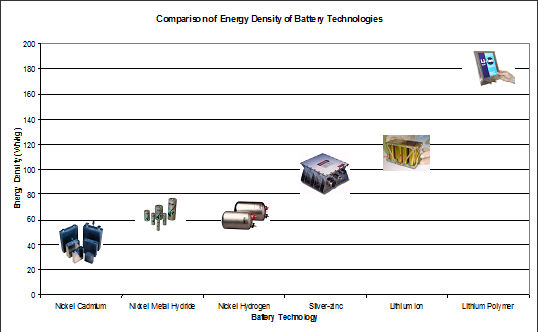SECONDARY BATTERIES
After 30 years of being the main battery technology used in space applications, the Nickel Cadmium (NiCd) battery is no longer the first choice energy storage system for space missions, despite the fact that the NiCd battery is a versatile energy storage device.
Among other qualities, NiCds are able to deliver large pulsed currents, they have a flat discharge profile, can be abused by overcharge and over-discharge and still perform their function. They have excellent cycling capability and lost capacity can generally be recovered by reconditioning. However, their main downside compared to other technologies, is that they have a low energy density (about 40Wh/kg). For missions where mass is not an issue, the NiCd battery is still a useful and often more affordable alternative to more modern technologies.
Surrey Satellite Technology Ltd (SSTL) has successfully used commercial NiCd cells in all of their spacecraft since UoSat2. By the implementation of a rigorous acceptance test program developed by SSTL, the commercial NiCd cells, more commonly found in portable video equipment, have been used for many years to power Surrey’s spacecraft in eclipse. The operating temperature range of NiCds is ideally between 0C and 25C. The expected cycle life of a NiCd is about 30000 cycles at no more than 25% depth of discharge (DoD).
Nickel Metal-Hydride (NiMH) is a technology that provides some performance advantages over NiCd in energy density (60Wh/kg), but this technology has yet to be proven in space. In the meantime, other technologies have emerged with more favourable characteristics, which will make it harder for the NiMH to become a popular choice for space missions. NiMH have an operating temperature of 0C to 25C.
Nickel Hydrogen (NiH2) batteries differ from most other spacecraft battery technologies by the fact that this technology was developed specifically for the space market. For many years, the NiH2 battery has been a popular choice mainly for geostationary missions where infrequent, high depths of discharge are required. NiH2 is used on both the Mars Global Surveyor and 2001 Mars Odyssey missions. The advantages of this technology are the fact that it not only has many years of life test data, it has also been successfully used on many missions over the last 10-20 years. The energy density of NiH2 is also more favourable than both NiCd and NiMH at 65Wh/kg. The drawbacks are the expense to manufacture with the cells being made to order, and commercial alternatives to the space qualified cells are not available for low cost spacecraft manufacturers. The operating temperature range of NiH2 is 0C to 20C. NiH2 has an expected cycle life of about 30000 cycles at 25% DoD.
Silver-Zinc battery technology has been used on a number of deep space missions, an example being the Mars Pathfinder mission. Silver Zinc Batteries are available as primary batteries and as rechargeable batteries. They have the advantage of having a reasonalbly high energy density, (about 100Wh/kg), high discharge current and high discharge voltage and extreme resistance against shock, acceleration and vibration. However, once the chemistry is activated, the lifetime of the battery is about six months or 100 cycles. The operating temperature is -20°C to +75°C.
As a result of several years of life testing, the recently developed Lithium ion (Li-ion) rechargeable battery has become the popular choice amongst mission designers. Li-ion battery technology offers spacecraft engineers a number of advantages over other battery technologies, including an energy density nearly double that of NiH2 at 120Wh/kg+. Testing has shown Li-ion to have cycling properties as good as NiCd and NiH2 for both low and high DoD applications. From a low cost spacecraft engineering perspective, Li-ion cells are widely available on the commercial market and used in many consumer electronics applications. The technology does have some drawbacks, including irrecoverable capacity fade with cycling (which is over come by sizing the battery for end of life) no resistance to overcharge, susceptible to permanent damage if over-discharged and is not suitable for providing high currents. The advantages of this technology far outweigh the drawbacks, and it is fast becoming the main energy storage technology used in space applications (Li-ion is used on ESA deep space missions Rosetta, RoLand, Mars Express, and many more missions including all of SSTL's recent small satellite missions). The main suppliers of lithium ion space batteries are ABSL (UK and North America) and SAFT. The operating temperature range of Li-ion is ideally between 0°C and 40°C for optimum performance.
The latest technology to enter the space energy storage market is Lithium Polymer (Li-Polymer). Li-Polymer offers energy density advantages over Li-ion with energy densities ranging from 180Wh/kg up. Due to their extremely lightweight packaging, the manufacturing techniques to produce spacecraft batteries may be as simple as gluing cells together. Caution needs to be taken when selecting commercial cells for space as bulging of the cell 'bag' can cause a significant reduction in capacity. Clyde Space have selected a lithium polymer cell for use on small satellites. This battery has undergone extensive testing to ensure compatibility with the space environment. The Clyde Space battery will be flown late 2007/early 2008 on multiple CubeSat missions.
